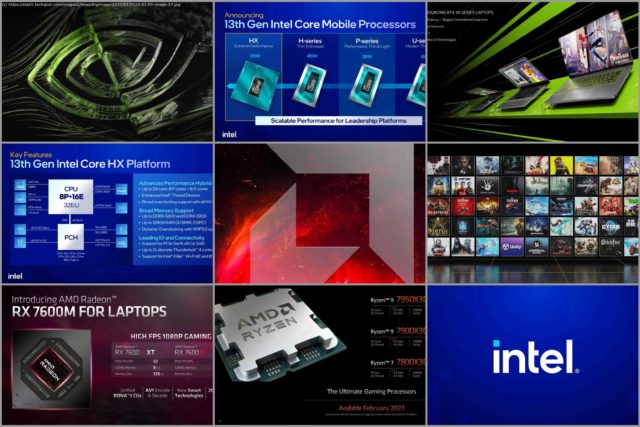This should be a good time for a CES 2023 news recap and analysis, with tons of PC hardware announcements as expected, and AMD having just concluded.
This should be a good time for a CES 2023 news recap and analysis, with tons of PC hardware announcements as expected, and AMD having just concluded its presentation. So let’s run through all the interesting stuff and give our thoughts on what’s been shown…
Starting from the most recent reveal this morning, AMD’s new Ryzen 7000 3D V-Cache CPUs. V-Cache debuted on the popular Ryzen 7 5800X3D last year, stacking a cache die on top of the CPU chiplet to significantly increase L3 cache capacity from 32 to 96 MB. The same sort of technology is now being deployed to Zen 4 Ryzen 7000 processors as well.
While before AMD only launched one V-Cache processor, with Zen 4 we are getting three new options. There’s the 7800X3D offering 8 cores and 16 threads, the 7900X3D offering 12 cores and 24 threads, and the 7950X3D with 16 cores and 32 threads. All are 120W parts and will be available in February.
There’s a couple of interesting things to note about these specs. First is clock speeds. With the 7950X3D we see the same 5.7 GHz max clock as the 7950X, and unlike with the 5800X3D vs 5800X there’s no reduction in turbo speed. However, to drop the TDP from 170W to 120W, base clocks are lower and we’d expect all core frequencies in typical applications to be lower than that of the 7950X. Same with the 7900X3D, which has the same 5.6 GHz max frequency as the 7900X.
However this isn’t the case for the 7800X3D, which lists just a 5.0 GHz max turbo clock. This is down from the 5.4 GHz max frequency we saw for the Ryzen 7 7700X. The large cache should offset this clock speed drop like we saw for 5800X3D vs 5800X, though the frequency reduction is larger with the Zen 4 8-core part compared to Zen 3.
Also interesting are the total cache figures. AMD lists both L3 and L2 cache combined, and the 7800X3D numbers make perfect sense. 32MB of on-chiplet L3 cache, 64 MB of 3D V-Cache and 8 MB of L2 cache, with 1MB per core with Zen 4. This totals 104 MB. With the Ryzen 9 parts though we have 140MB and 144MB of combined cache listed. This suggests only one of the two CPU core chiplets has received V-Cache. The 7950X already has 64MB of L3 plus 16MB of L2, or 80MB of total cache. To jump up to 144MB as seen here there must be just 64MB of additional V-Cache, which implies one set of V-Cache on one chiplet, while the other chiplet is just a regular chiplet with no V-Cache.
That’s an interesting configuration that seems gaming optimized, as most games avoid using more than one chiplet on AMD’s dual-chiplet Ryzen 9 parts. It wouldn’t make a lot of sense to add V-Cache to a chiplet that won’t actually be used for gaming. But it also means that thread scheduling needs to be spot on for these parts, always allocating games to the CPU chiplet that contains V-Cache.
Otherwise these new Ryzen 9 V-Cache parts look ideal for people that use their systems for both gaming and productivity: something like the 7950X should offer excellent multi-thread performance while also having top-end speed for gaming enhanced through a huge L3 cache on one die.
AMD is claiming with their benchmarks — that you should definitely take with a huge grain of salt — that the 7800X3D is between 21 and 30 percent faster than the 5800X3D across a four game sample at 1080p using high image quality. That’s a substantial gain, and should push this part into the top spot on the gaming chart.
AMD is claiming a 13 to 24 percent performance lead over the Core i9-13900K with the 7950X3D, previously the 13900K has been the top gaming part, but AMD’s marketing is suggesting otherwise. No direct performance comparisons were shown pitting Zen 4 against Zen 4 V-Cache, but we know the 5800X3D, 13900K and Zen 4 are all quite competitive so these new X3D parts should be around 15% faster than Zen 4 – a similar uplift from V-Cache with the previous generation.
Hopefully this will breathe some life into the AM5 platform which has been struggling from low sales and interest compared to AM4.
The next major announcement from CES has been the introduction of new affordable processors from both AMD and Intel – we’ve got the 65W non-X Zen 4 parts from AMD, and the 13th-gen non-K lineup from Intel.
On the AMD side, the Ryzen 9 7900 is basically a 7900X with the max clock dropped from 5.6 to 5.4 GHz and lower multi-core clocks as the TDP drops from 170W to 65W. This part will come in at $430, down from the 7900X’s launch price of $550, although these days the 7900X can be found for around $460.
Similar story for the Ryzen 7 7700 and Ryzen 5 7600. The TDP drop isn’t as dramatic here as both parts go from 105W to 65W, and clock speeds are down either 100 or 200 MHz in terms of boost clock.
The big improvement is pricing, with the 7700 sitting at $330 and the 7600 at $230, which are $70 discounts compared to the launch pricing of the X models. However like with the 7900 they’re less of a discount relative to current pricing, as the 7700X can be found for just $345, while the 7600X has occasionally fallen to $260.
When buying a non-X model you’ll also get a box cooler, the Wraith Prism for the Ryzen 7 and 9, and a Wraith Stealth for the 7600. Zen 4 CPUs previously did not come with a box cooler, but it makes sense that the more affordable budget models would go back to including these.
Intel has also announced a huge suite of new 13th-gen Core non-K CPU models for affordable systems. These include standard locked models with integrated graphics, as well as F models without graphics, most of which are 65W parts. There’s also the T series, which drops the TDP further to 35W, though these parts are mostly destined for pre-builts.
The core configuration is identical to Intel’s unlocked Raptor Lake models for the higher-end parts in the lineup. So, for example, the Core i7-13700 has 8 P cores and 8 E cores, which is also true of the 13700K. However, clock speeds are lower, dropping from 5.4 to 5.2 GHz on the P cores and 4.2 to 4.1 GHz on the E cores.
When run in its TDP limited state at the 65W default, all core frequencies will be a lot lower than the 125W unlocked models – however many motherboards will run these in a power unlimited state by default, reducing the margins and increasing performance.
While all of these parts are 13th-gen models, Intel is using a mixture of Raptor Lake and Alder Lake silicon, though it’s not 100% clear which CPUs use which architecture.
It’s expected that the Core i7 and Core i9 parts are Raptor Lake, while the Core i5s and below are refreshed Alder Lake. But that doesn’t mean we are seeing the exact same configurations as 12th-gen. For example, the 13400F is now a 10-core processor with 6 P cores and 4 E cores, while the older popular 12400F was just a six-core model, with 6 P cores and no E cores.






